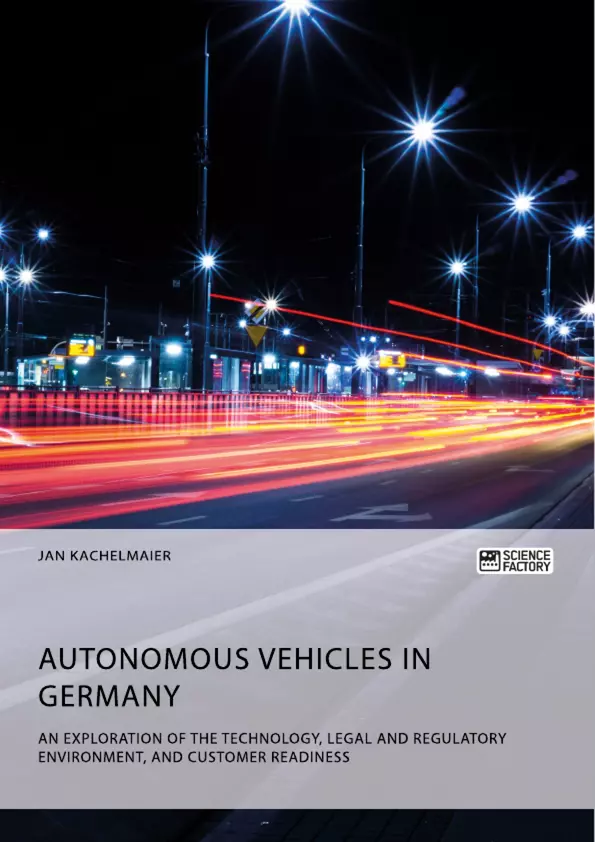The automobile industry is one of Germany’s strongest and most important industries. But while German carmakers still struggle with the diesel emission scandal, the whole sector is facing a great revolution. Various companies are working intensively on the development of the next major milestone in mobility that incorporates the megatrends of electric, connected, shared and autonomous driving. The combination of these trends can reduce CO2 emissions and eliminate a significant portion of traffic jams while increasing mobility and space utilization in urban areas.
The technology of autonomous driving is perceived to be disruptive and thus many challenges and obstacles remain before the new technology becomes superior to human drivers. Jan Kachelmaier explores the status quo of the development of autonomous vehicles at German Manufacturers. The author identifies future impediments until market entrance and recommends managerial actions.
Keywords:
- Autuonomous Vehicles;
- Artificial Intelligence;
- Germany;
- Transportation;
- Car Sharing
Inhaltsverzeichnis (Table of Contents)
- Abstract
- List of Abbreviations
- List of Figures
- List of Tables
- 1 Introduction
- 2 Literature Review
- 2.1 The History and Development of the German Automobile Industry
- 2.2 Autonomous Driving
- 3 Research Aims and Contribution
- 3.1 Research Aim
- 3.2 Significance of the Study
- 3.3 Research Question and Objectives
- 4 Methodology
- 4.1 Research Design
- 4.2 Data Collection
- 4.3 Sampling Strategy
- 4.4 Data Analysis
- 5 Primary Research Analysis
- 5.1 Qualitative Analysis
- 5.2 Quantitative Analysis
- 6 Discussion
- 6.1 Technology
- 6.2 Legal and Regulatory Environment
- 6.3 Customer Readiness
- 6.4 Key Recommendation for German OEMs
- 7 Guidance for Future Research
- 7.1 Theoretical and Methodological Limitations
- 7.2 Suggestions for Future Research
- 7.3 Personal Reflection of the Paper
- References
- Appendices
Zielsetzung und Themenschwerpunkte (Objectives and Key Themes)
This research paper aims to explore the current state of autonomous vehicle development within German OEMs. It aims to identify future obstacles hindering market entry and provide managerial recommendations for achieving successful implementation. The paper focuses on three key pillars: technology, legal and regulatory environment, and customer readiness. The research analyzes data from interviews with experts from OEMs and automobile associations, along with surveys of potential German end-users. Here are some key themes explored in the paper:- The impact of the diesel emission scandal on the German automobile industry's image and future.
- The challenges and obstacles associated with the development and implementation of autonomous vehicles.
- The legal and regulatory framework surrounding autonomous vehicles in Germany.
- The level of customer readiness for autonomous vehicles in Germany.
- Recommendations for German OEMs to successfully navigate the transition to autonomous vehicles.
Zusammenfassung der Kapitel (Chapter Summaries)
- **Introduction:** This chapter introduces the topic of autonomous vehicles, their significance for the German automobile industry, and the challenges and opportunities associated with their development and implementation.
- **Literature Review:** This chapter provides a comprehensive overview of the history and development of the German automobile industry, as well as an in-depth discussion of the current state of autonomous driving technology.
- **Research Aims and Contribution:** This chapter outlines the research aim, significance, research question, and objectives of the study.
- **Methodology:** This chapter describes the research design, data collection methods, sampling strategy, and data analysis techniques employed in the study.
- **Primary Research Analysis:** This chapter presents the findings from the qualitative and quantitative analysis of data collected through interviews and surveys.
- **Discussion:** This chapter discusses the key findings of the research and provides recommendations for German OEMs to effectively navigate the transition to autonomous vehicles.
- **Guidance for Future Research:** This chapter explores the limitations of the study, proposes future research directions, and reflects on the personal insights gained from the research process.
Schlüsselwörter (Keywords)
The research paper focuses on the development and implementation of autonomous vehicles in Germany, examining key themes such as the technological advancements, legal and regulatory frameworks, and customer readiness. The paper explores the challenges and opportunities facing German OEMs in this evolving market and provides recommendations for navigating these complexities. The primary focus areas include autonomous driving technologies, German automobile industry, legal and regulatory environment, customer adoption, and strategic implications for OEMs.- Quote paper
- Jan Kachelmaier (Author), 2018, Autonomous Vehicles in Germany. An Exploration of the Technology, Legal and Regulatory Environment, and Customer Readiness, Munich, GRIN Verlag, https://www.grin.com/document/434744



